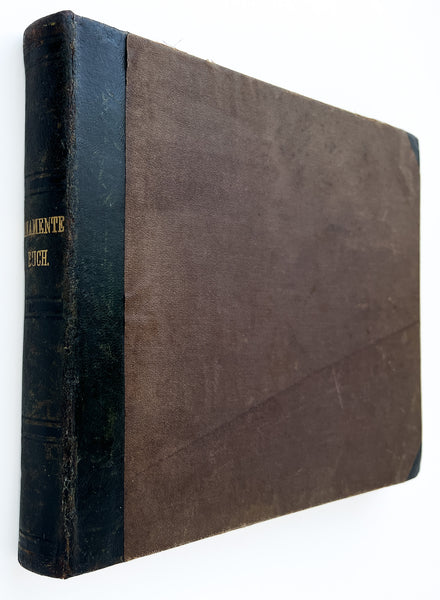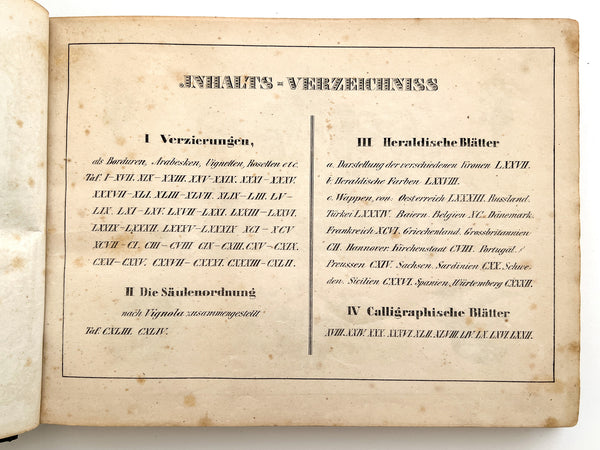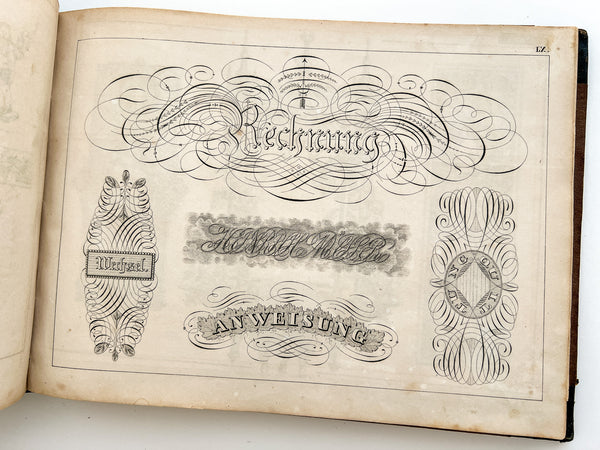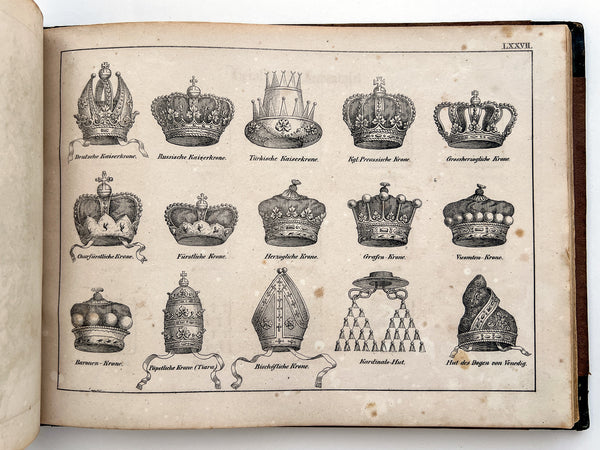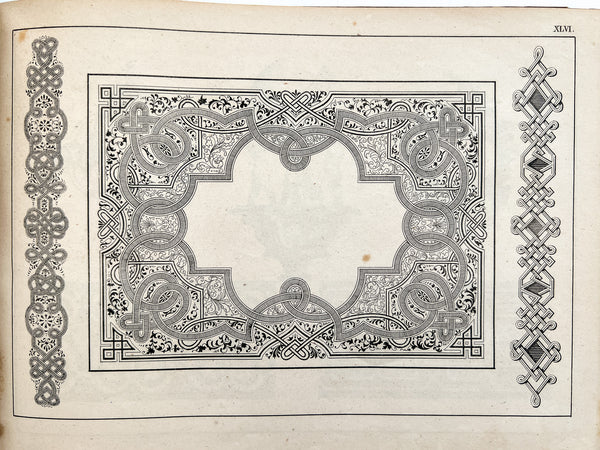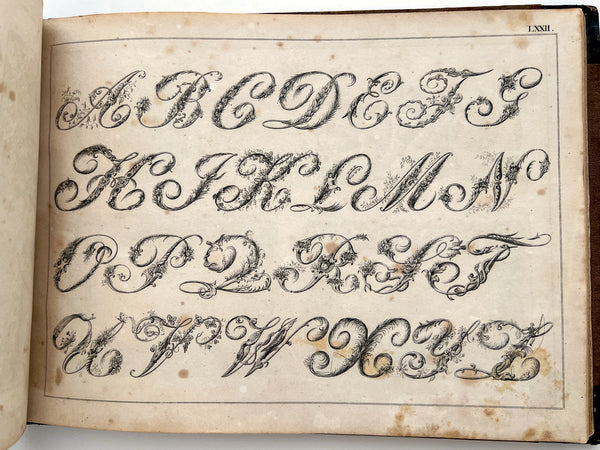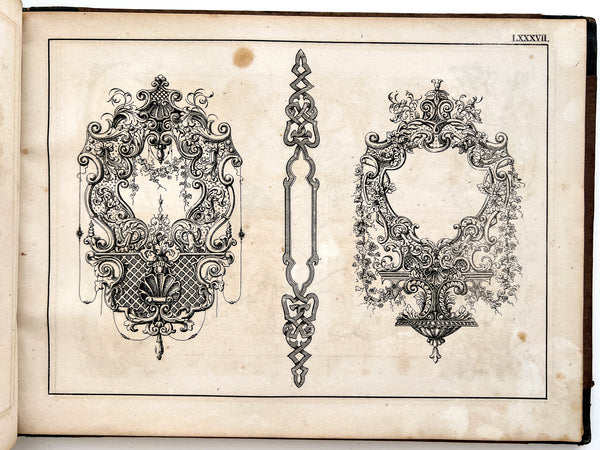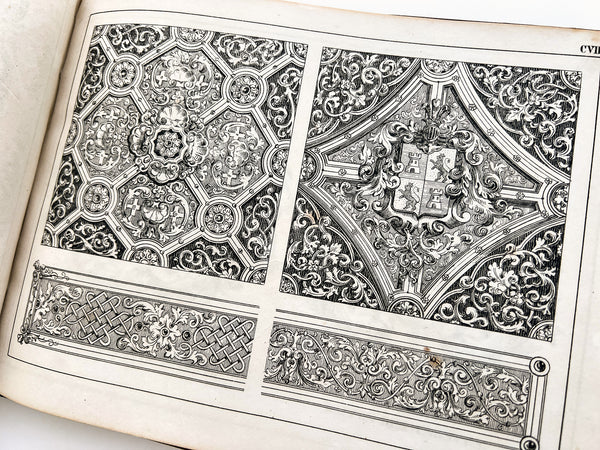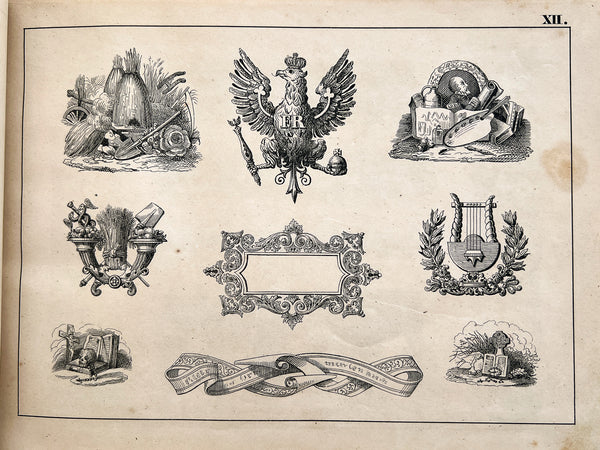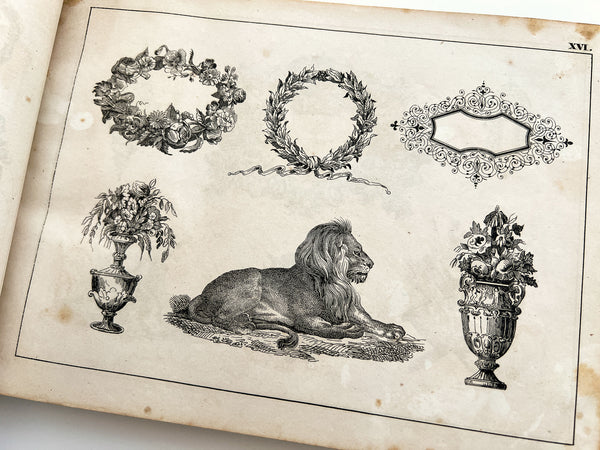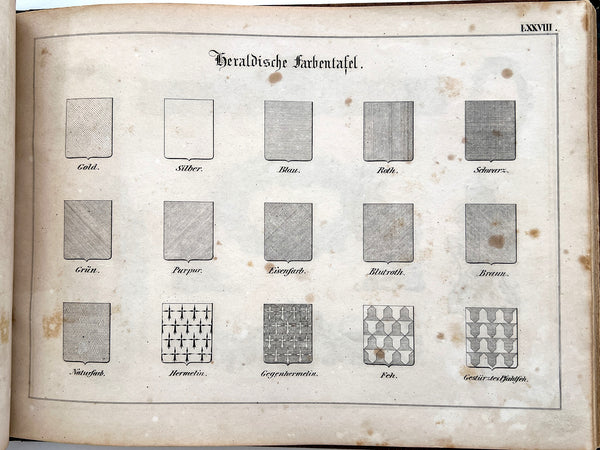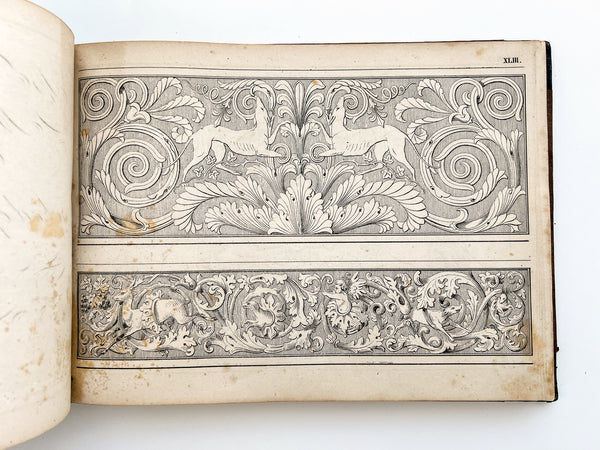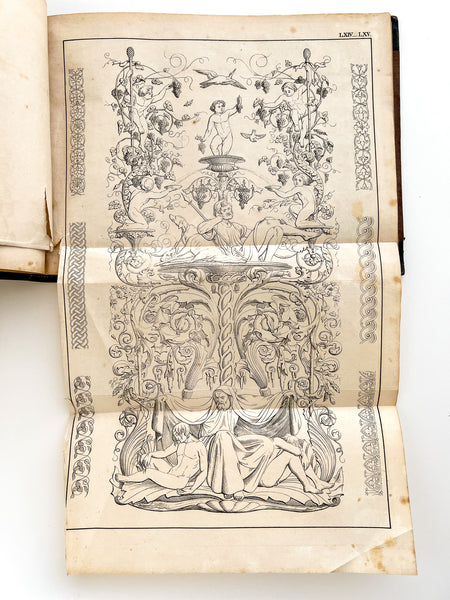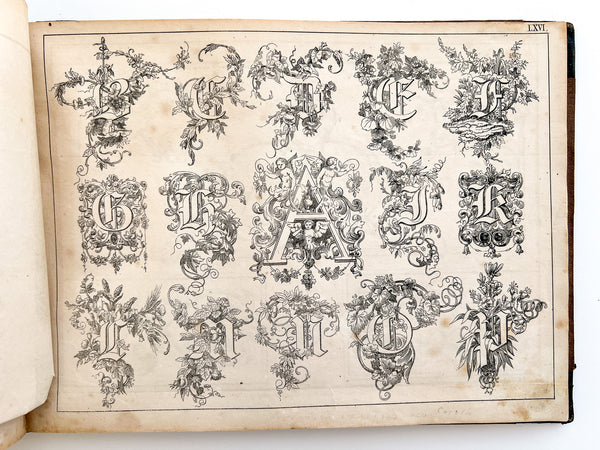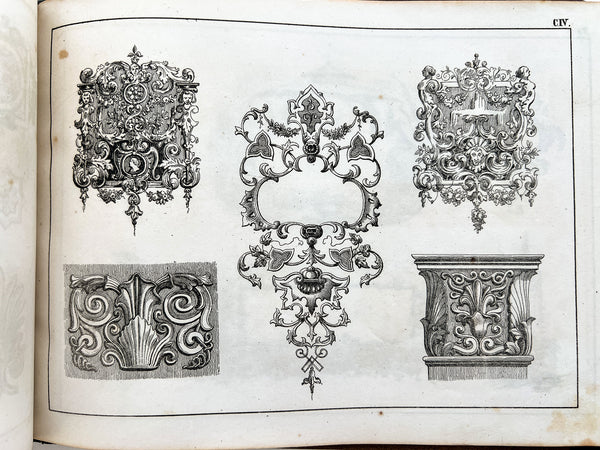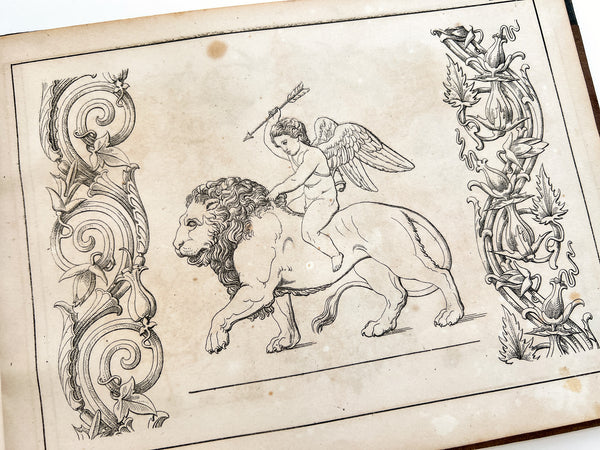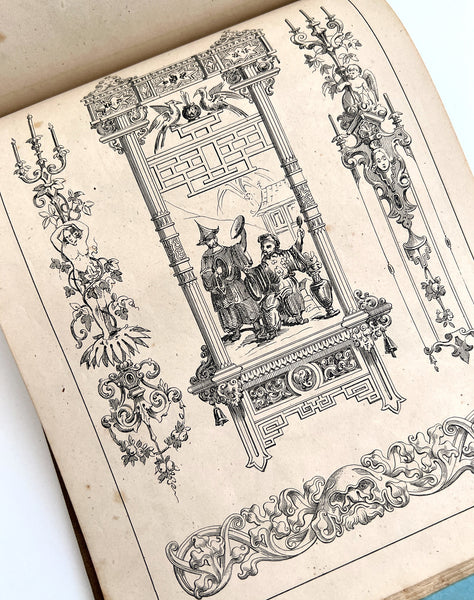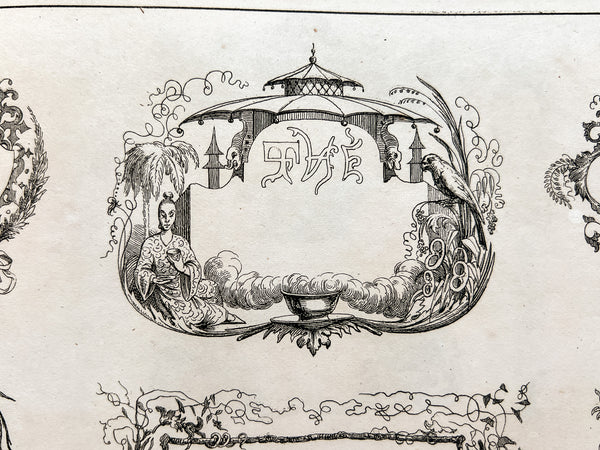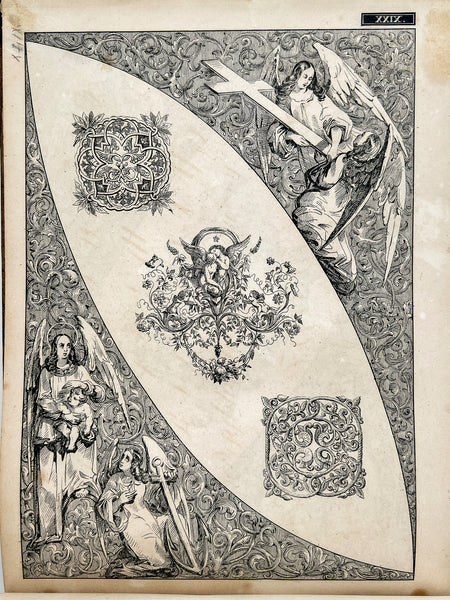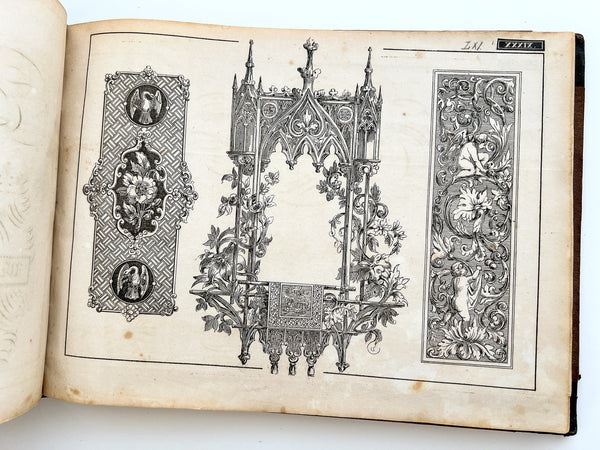Kleines Ornamentenbuch, oder: Sammlung der verschiedenartigsten Verzierungen im neuesten Geschmack...
...als: Arabesken, Borduren, Vignetten, Rosetten u.s.w. … Ein Hilfsbuch für alle bildenden Künstler, insbesondere für Zeichner, Maler, Architekten, lithographen, Gold - und Silber arbeiter, Graveure, Bronzirer, Gürtler, Formstecher u.s.w.
Printed on different paper stocks with tonal variations. Oblong small quarto; [2], 144 plates (2 folding). Half leather with mauve cloth boards. A Very Good copy with mild to moderate foxing in varying degrees throughout. Rubbing to extremities, ink stain on the rear board. A few plate numbers have been written in pencil where it appears plates were directly reproduced from another published volume (with that original plate number still visible). Additional penciling on the endpapers, noting plate numbers. Signature and pencil annotation to the endpapers by Peter Eifel, a Chicago stone carver who immigrated from Germany in the 1860s. Originally published in sections, the complete run appears here in a modest binding with the bookseller’s ticket on the pastedown “Deutsche und Franz, Buchhandlung und Leihbibliothek, von Edw. Bühler” (Edward Buhler, dealer in German and French music and circulating library).
Published in parts from ca.1844-47, Kleines Ornamentenbuch is advertised beginning in 1844 as “a collection of the most diverse decorations in the latest taste as attributes, arabesques, vignettes, rosettes, borders, etc. An aid book for all visual artists, especially for draftsmen, painters, architects, lithographers, gold and silver workers, engravers, bronzers, belters, engravers, etc,” (a description reused here as the subtitle of this collection). Notices appeared in publications including Beilage zur Allgemeinen Zeitung (Allgemeine Zeitung München); Journal für Buchdruckerkunst, Schriftgießerei und verwandte Fächer Volume 13, 1846; and Berliner Gewerbe-, Industrie- und Handelsblatt. The number of plates advertised grew–up to 108 in 1846, and finally 144 in 1847–all accounted for in this copy, bound together with a title page and table of contents.
As advertised, the designs are as copious as they are varied. Mottoes, emblems, heraldic coats of arms, alphabets, architectural elements, and every flavor of ornament. No designs are credited, and most appear to be copied from other published works–either directly from plates, as in the case of illuminated alphabets and architectural ornaments, or by lifting elements from printer’s devices, pictorial title pages, architectural plates, etc. Some have distinct English, Italian, and French styles, with more surprising contributions taken from Eastern cultures.
The extent and timeline of these reproductions, as well as the publisher’s primary location in Lissa (which seems rather off the beaten track in terms of the trade), suggest the work benefited from the lenient early copyright laws in Germany. While no such laws existed at all until 1837, those that were introduced were easily circumvented due to the jurisdictional divisions between German states. An OCLC search for works published by Ernst Günther returns around 100 reference works in education, medicine, and the law, which makes this exclusively graphic production stand out. Of course, without the title page, these plates lack any indication of Günther’s involvement, so it is conceivable he had similar endeavors fly under the radar. He published several legal texts by A. Alker, including Preussens Pressgesetze und der Buchhandel in Preussen, a treatise on laws related to the print and publishing trades. It specifically addressed (and advocated) for the rights of lithographers to reprint material, among arguments for free press and against censorship. Its publication in 1843, just before the Ornamentenbuch series began publication, is apt.
Historians have argued that Germany’s elusive copyright laws, and the resulting proliferation of printed material, facilitated an intellectual and cultural stimulation that led to the country’s early industrial dominance. In this case, the reproduction of these images and their marketing toward craftsmen promoted the spread of visual literacy, equipping a growing legion of industrial arts workers with the graphic delicacies of expensive and historical works previously accessible only to the privileged. Tradesmen could in turn reproduce those designs on a larger scale, promoting the proliferation and demand for pleasing aesthetics in everyday life.
In an arguably fitting commercial turn of events, the Kleines Ornamentenbuch specimens were reprinted in Dover’s Pictorial Archive Series as 800 Classic Ornaments and Designs in 1999, once more disseminating the “lavish” designs to the general public. Dover promotes the designs as, “ideal for enhancing such print projects as ads, brochures, newsletters, posters, signs, catalog copy, and much more.” An aesthetically bereft production that certainly fails to do justice to these designs, their co-opting of the plates is a fitting commercial throughline, with similarly florid promotional text:
Graphic artists, illustrators, and craftspeople will welcome this treasury of beautifully engraved ornate frames, scrollwork, and other highly decorative designs — 800 in all — reproduced from an extremely rare mid-19th-century style book.… a lavish assortment of ornaments, bedecked with flowers, mythological creatures, and other fanciful touches, all beautifully rendered in meticulous detail. Other striking designs incorporate a rich selection of classical columns, plus heraldic designs — shields, coats-of-arms, seals, and insignias from Austria, Russia, Denmark, France, and many other countries — for a touch of medieval flair or aristocratic ambience…
Evidently quite scarce: Rarebookhub shows an incomplete copy lacking 21 plates passed at auction in 2005 (Zisska and Kistner). The title matches 2 Worldcat listings: 1 copy, LIBRIS (Sweden) Attributed to Günther, but inconsistent pagination (142 s., [2] s). The second listing has 3 copies, not attributed to Günther, but with the correct number of plates: Staatliche Museen zu Berlin, Preußischer Kulturbesitz, Kunstbibliothek; Sächsische Landesbibliothek - Staats- und Universitätsbibliothek Dresden; Germanisches Nationalmuseum, Bibliothek.
The Dresden copy has been digitized and hosted on SLUB. It shows several notable differences in some of the early plates, many of which are printed in reverse with different typography for the plate numbers. The image reversal and quality may indicate the original litho stones had worn and needed to be remade. Two of the plates are entirely different: Plate XIV (ours includes two portrait vignettes vs. assorted architectural design) and XXIV (Italianische Alphabete in this copy, Romische Schriften in the digital copy). Errors regarding plate numbers have also been corrected in the digital copy, suggesting our copy is earlier. Other than anomalies attributed to scanning, the remainder of the plates match up.
References:
Thadeusz, Frank. “No Copyright Law: The Real Reason for Germany's Industrial Expansion?” Der Spiegel (2010).
Roger Paulin. (2014). [Review of Geschichte und Wesen des Urheberrechts, by Eckhard Höffner]. The Modern Language Review, 109(4), 1130–1132. https://doi.org/10.5699/modelangrevi.109.4.1130




























